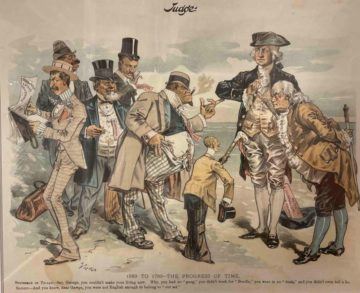Jon Grinspan in Smithsonian:
 Nearly every day while writing my new book, The Age of Acrimony: How American’s Fought to Fix Their Democracy, I would walk across the National Mall in Washington, D.C., to my office at the Smithsonian’s National Museum of American History. I’d pass tourists wearing MAGA hats and protestors waving angry signs. In the museum’s secure collections, I’d settle into the cool, quiet aisles that preserve the deep history of our democracy. There, century-old objects—torches from midnight rallies, uniforms from partisan street gangs, ballots from stolen elections—told a forgotten drama of fractious and furious partisanship. Most people don’t often think about the politics of the late 1800s. Call it “historical flyover country,” an era stranded between more momentous times, when U.S. presidents had funny names and silly facial hair. But for our current political crisis, this period is the most relevant, vital and useful. The nation’s wild elections saw the highest turnouts and the closest margins, as well as a peak in political violence. Men and women campaigned, speechified and fought over politics, in a system struggling with problems all too familiar today.
Nearly every day while writing my new book, The Age of Acrimony: How American’s Fought to Fix Their Democracy, I would walk across the National Mall in Washington, D.C., to my office at the Smithsonian’s National Museum of American History. I’d pass tourists wearing MAGA hats and protestors waving angry signs. In the museum’s secure collections, I’d settle into the cool, quiet aisles that preserve the deep history of our democracy. There, century-old objects—torches from midnight rallies, uniforms from partisan street gangs, ballots from stolen elections—told a forgotten drama of fractious and furious partisanship. Most people don’t often think about the politics of the late 1800s. Call it “historical flyover country,” an era stranded between more momentous times, when U.S. presidents had funny names and silly facial hair. But for our current political crisis, this period is the most relevant, vital and useful. The nation’s wild elections saw the highest turnouts and the closest margins, as well as a peak in political violence. Men and women campaigned, speechified and fought over politics, in a system struggling with problems all too familiar today.
In 1910, the influential Kansas journalist and eventual leader of the progressive movement William Allen White wrote: “The real danger from democracy is that we will get drunk on it.” White’s warning about the intoxicating potential of politics came at a turning point, just as the raucous politics of the 1800s were sobering up into the more temperate style of 20th-century America.
More here.
